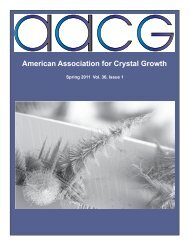President's Corner (cont.) - American Association for Crystal Growth
President's Corner (cont.) - American Association for Crystal Growth
President's Corner (cont.) - American Association for Crystal Growth
You also want an ePaper? Increase the reach of your titles
YUMPU automatically turns print PDFs into web optimized ePapers that Google loves.
conditions. We believe that grey tracking is mainly due to<br />
impurities within the material. This is minimized by using<br />
high purity starting material (>5N) and maintaining the oxidation<br />
state of Ti in the 4 plus state by chemical means. APC<br />
has also developed a KTP growth protocol with additional<br />
purification of the starting material (>7N) <strong>for</strong> increased<br />
per<strong>for</strong>mance. A typical boule is shown in figure 2. Using<br />
400 ml autoclaves, SHG parts up to 5x5x8 mm 3 and OPO<br />
crystals up to 30 mm long can be provided. Larger 1600<br />
ml autoclaves produce material suitable <strong>for</strong> 10x10x12 mm 3<br />
SHG parts.<br />
APC is currently in the 2nd year of a NSF Phase II SBIR<br />
award (IIP – 1058055) <strong>for</strong> HTG of KBe 2 BO 3 F 2 (KBBF) and<br />
its crystalline analogs such as RbBe 2 BO 3 F 2 (RBBF). Figure<br />
3 shows a hydrothermally grown RBBF crystal approxi-<br />
Figure 2. Typical KTP boule.<br />
Figure 3. Hydrothermally grown RBBF.<br />
mately 9 mm across the face and 4 mm thick. These materials<br />
are suitable <strong>for</strong> frequency conversion down to 176 nm<br />
and have very high laser damage thresholds. The growth<br />
and materials are covered under US patents 7,540,917 and<br />
7,731,795 and APC is the only commercial producer outside<br />
of China. This product will be launched during the last<br />
quarter of 2012.<br />
The layered structure of these materials presents a challenge<br />
<strong>for</strong> growth and fabrication. APC’s approach has been to produce<br />
RBBF – since the Rb ion is larger than the K ion, it fits<br />
better between the fluroborate layers and makes the material<br />
less micaceous. This increases the material hardness and<br />
robustness, making it easier to fabricate optical components.<br />
Other materials under development at APC are Sc 2 O 3 ,<br />
X:YAG, X:LuAG, Ce:Pr:LuBO 3 , with additional materials<br />
anticipated from our collaborators at Clemson University.<br />
Advanced Photonic <strong>Crystal</strong>s (www.apcrystal.com) is located<br />
in at a 3300 sq. ft. R&D and manufacturing facility<br />
in Fort Mill SC near the border of Charlotte NC. Our facility<br />
<strong>cont</strong>ains both office and laboratory space suitable <strong>for</strong><br />
preparatory and characterization and a hydrothermal growth<br />
room with numerous growth stations to handle a variety of<br />
commercial scale autoclaves. We currently have 17 growth<br />
stations with the ability to install 5 more.<br />
AACG Newsletter Winter 2013 13




